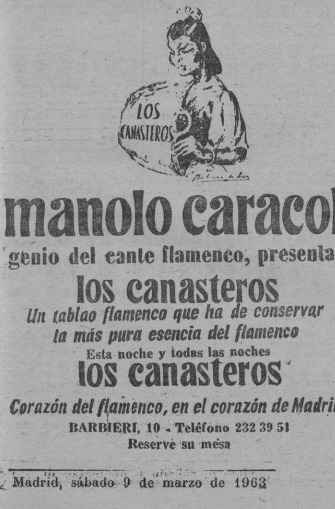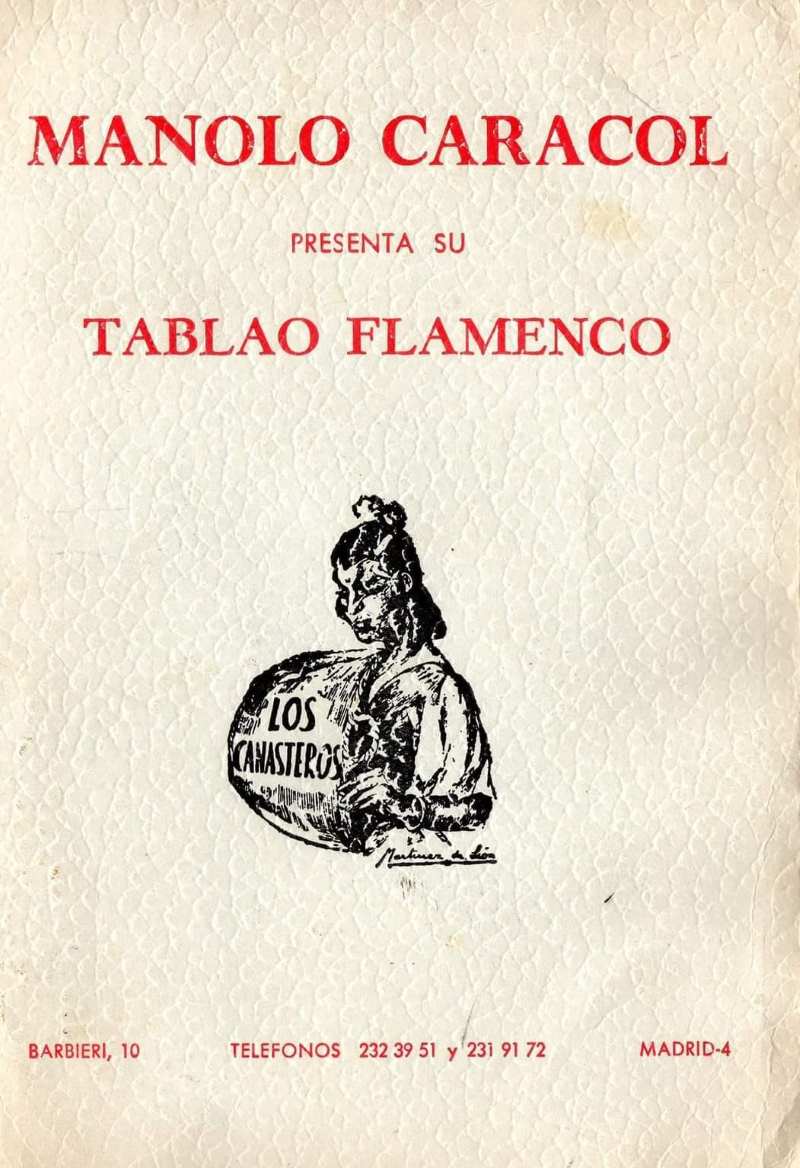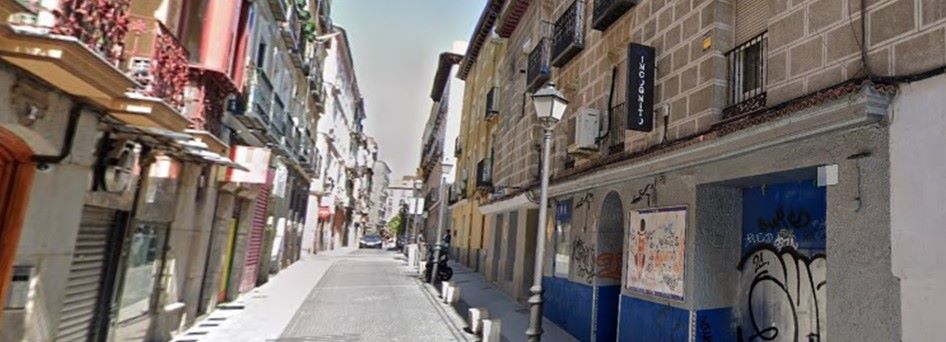Manolo Caracol opened Los Canasteros in 1963 to safeguard true flamenco. “No mixed artists”, would say this Sevillian singer. Today there is nothing left of what was the most important and aristocratic tablao in Madrid.

Postal del tablao Los canasteros en Madrid.
In Calle Barbieri number 10 in Madrid, next to Gran Vía, Manolo Caracol inaugurated the tablao Los Canasteros in 1963. Y lo dirigió personalmente hasta aquel fatídico accidente de tráfico de 1973 que nos dejó sin su voz afillá y única.
Practically, the singer of Sevillian origin locked himself within its walls for the 10 years in which he was in charge. Antonio Mairena, his “rival”, reigned at that time in flamenco festivals, so he was not “invited” to almost any. So, from the opening of Los Canasteros, Manolo Caracol decided that he would perform only in his tablao, with very few exceptions. Melchor de Mairena would be his star guitarist and his son-in-law, Arturo Pavón, the official pianist.
The tablao Los Canasteros was inaugurated on March 1, 1963 with a great performance by Manolo Caracol with the piano of Arturo Pavón
Foreigners feel flamenco more than many Spaniards”
Immediately, criticism rained down. And with phrases like “foreigners feel flamenco more than many Spaniards”, Manolo Caracol responded to those who questioned that in a tablao good flamenco could be given. And when entering, on the left, where the bar counter, three portraits: Antonio Chacón, Enrique el Mellizo and Manuel Torre. Quite a declaration of intent.
What’s more: in case there were any doubts, the place was advertised as “the tablao that has to preserve the purest essence of flamenco”.

Anuncio de 1963 en Pueblo.

Pase de mano de Los Canasteros.
The very same Manolo Caracol distributed the cards of the tablao As if it were “the public relations” of a modern nightclub.
“No mixed artists,” said this Sevillian singer in an interview in April 63. The journalists of the time wrote of Los Canasteros that he was “authentic”, “aristocrat”, “the best”, perhaps remembering that the Sevillian cantaor was a special guest of Francisco Franco.
Such was the success of Los Canasteros, that the Duchess of Alba, Cayetana Fitz-Sutart, baptized it as “the Royal Theater of the gypsies”
The tablao, with two floors, had in the background a stage in the style of those of the caves of Sacromonte (Granada). Before him, elegant tables that were filled with politicians, nobles, bullfighters, actors and fans of all kinds. Thick curtains from La Alpujarra guaranteed a warm and discreet atmosphere.
Thick curtains from La Alpujarra guaranteed a warm and discreet atmosphere.
The quantity and quality of the artists who stepped on the tablao of Caracol was impressive. From a young Manuela Carrasco to Antonio El Bailarín himself, who was already a myth. Singers who started, such as Pansequito or La Susi, or guitarists who would be consecrated on their stage, such as Enrique de Melchor or Sorderita.
Pepe Marchena, Juanito Valderrama. La Niña de los Peines, María Vargas, Juana Loreto, Fernanda de Utrera and Paco de Lucía also performed in the historic tablao.
Afterwards, with the place closed to the public, the night would continue to be washed down with red wine, drinks, good ham and a lot of flamenco. Because there were only the artists left, who debated, improvised songs and were inspired by the chord of the guitars. Ava Gardner, who lived in Madrid trying to forget Frank Sinatra, was a regular, although not so much for Caracol as for how handsome a flamenco singer named Bambino was.
Enrique de Melchor learned from those great figures behind a curtain until his uncle, Manolo Caracol, gave him the opportunity to act when he was only 15 years old: “I was very lucky. At this time it would be very difficult to have those great masters,” he would say years later.

Manolo al cante y Pavón al piano. Foto: Instituto de Cultura Gitana.

Manolo Caracol en Los Canasteros. TVE
From tablao to VIP disco
The tragic death of Manolo Caracol led to the temporary closure of Los Canasteros. His sons and Arturo Pavón tried to refloat it, but finally, the tablao Los Canasteros closed definitively in 1993.
The place would be occupied by El Patio de la Carreta, dedicated to Argentine tango, although once a week flamenco was played. Cancanilla de Málaga would perform on one of those occasions.
Later, in 96, he would open a nightclub called Sala Polana through which famous and famous people passed. After years between bar and gay room, it was put up for sale for almost 4 million euros (the price included four apartments located in the same building). Today, the image below these lines is what remains of the “temple of the gypsies”, Los Canasteros.

La calle y el edificio del antiguo tablao Los Canasteros.

Sala Polana en 2017.
